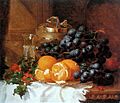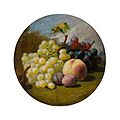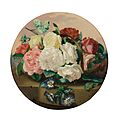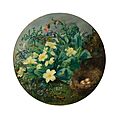Eloise Harriet Stannard facts for kids
Quick facts for kids
Eloise Harriet Stannard
|
|
|---|---|
 |
|
| Born | 1 February 1829 Norwich, England
|
| Died | 1915 |
| Nationality | English |
| Known for | Still life painting |
| Movement | Norwich School of painters |
Eloise Harriet Stannard (born 1829, died 1915) was a talented British painter from the 1800s. She was famous for her beautiful still life paintings. These are artworks that show objects like fruit, flowers, or everyday items. Eloise was one of only two important women artists linked to the Norwich School of painters. This was Britain's very first art group outside of London.
Contents
About Eloise Stannard
Eloise Harriet Stannard was born in Norwich, Norfolk, England, on February 1, 1829. She was one of fourteen children! Her father, Alfred Stannard, was a landscape painter and drawing teacher. Her uncle, Joseph Stannard, was also a painter. Both her father and uncle were part of the Norwich School of painters.
Family of Artists
Eloise and her aunt, Emily Coppin Stannard (who was Joseph's wife), became the only two well-known women artists in the Norwich School. It's likely that Eloise learned to paint from her father. Her painting style was inspired by older Dutch still life artists, especially a painter named Jan van Huysum.
Her Unique Painting Style
Eloise mainly painted fruits. She often showed fruits that didn't grow in England at the time. She would pile them up in baskets and bowls. Her paintings usually had a plain background and natural light. Sometimes, she even added tiny insects to her artwork!
Eloise used very fine brushstrokes and many layers of paint. This made her paintings look bright and glowing. Today, many people think Eloise Stannard was one of Britain's most gifted still life painters.
What People Thought of Her Work
A writer named Harold A.E. Day once described her art. He said that Eloise Stannard's paintings showed amazing good taste. He also said her careful painting style and talent made her one of the best British still life painters of her time.
Her Career as an Artist
Even though Eloise Stannard had poor health, she kept painting actively. She showed her artwork often and became very successful. She was so good that she never needed to teach students. This was unusual for women artists in the 1800s, who often had to teach to earn money.
Exhibitions and Recognition
Eloise started showing her paintings in 1852. She exhibited her work at many important places. These included the British Institution (from 1852 to 1867) and the Royal Academy of Art (from 1856 to 1893). She also showed her art at the Royal Society of British Artists and the Royal Glasgow Institute.
In 1859, a magazine called the Art Journal praised her work. They said her painting of "Fruit" was done with wonderful skill. They also noted how closely it looked like real, ripe fruit.
A Special Compliment
In 1857, Eloise received a special compliment from George Nicol. He was the Secretary of the British Institution. He shared a story about a famous painter named Mr. Lance. Mr. Lance saw one of Eloise's round paintings and was very impressed. He said it was "so good" and admired the painted grapes especially. When he found out a lady named Miss Stannard painted it, he said, "Then it does her infinite credit." This shows how much her work was respected.
Later Life and Work
In 1871, Eloise Stannard was asked to be a judge for the Female School of Arts. However, her poor health stopped her from accepting the invitation. She became a member of the Society of Women Artists in the same year.
After 1873, her mother passed away. Eloise then had more family duties. Because of this, her paintings became smaller, and she showed her work less often.
One of her famous paintings, Strawberries in a Glass Lid with Glass Bowl of Raspberries Behind (from 1896), is displayed at Norwich Castle. This castle has the largest collection of artworks by Norwich School artists.
Images for kids







